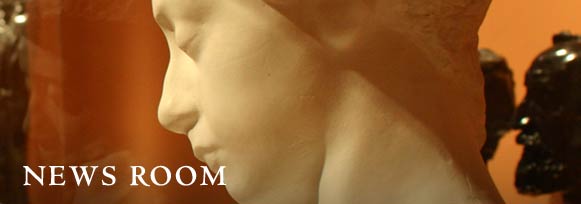Rodin's Monument To Victor Hugo
January 26 - March 26, 2000
Contact: Bernard Barryte, Chief Curator, 650-725-0466; or Jill Osaka, Public Relations Manager, 650-725-4657.
STANFORD, CA DECEMBER 1999—The exhibition Rodin's Monument to Victor Hugo opens to the public on January 26, 2000. It explores the response of Auguste Rodin, an artist who manifested his genius in sculpture, to Victor Hugo, an artist who manifested his genius in words. Sketches and studies in bronze, marble, plaster, and terra cotta enable viewers to trace the formation of Rodin's Monument, a 2,750 pound bronze not seen in America prior to this exhibition.
Poet, playwright, author of such novels as The Hunchback of Notre-Dame and Les Misérables, Victor Hugo (1802-1885) was revered not only as the most famous literary figure of his day but also as the ardent spokesman for the democratic principles of the French republic. When Hugo died, more than one million people followed his body to its resting place in the Pantheon, a secularized church in which "great men" are celebrated by "their grateful country."
Awarded the official monument commission in 1889, Rodin struggled for a decade to create an appropriate tribute to this literary colossus. The resulting monument embodies the concept of artistic creativity in an extraordinary fashion. Hugo is portrayed as a meditative genius, powerful as a giant, who is roused by inspiration sweeping over him as the muse of history and legend rises from the sea.
Like all of Rodin's public projects, this enterprise suffered a complicated fate for political and aesthetic reasons. The incomplete plaster model was admired when it was exhibited at the Salon of 1897. Though the plaster was brought to completion shortly after 1900, the statue was not cast in bronze until the 1960s. This same plaster served as the matrix for the magnificent bronze, commissioned in 1995, that is featured in this exhibition. In addition, twenty-two studies and sketches in various media—augmented by rare documentary photographs from the Center's collection—describe the various stages in the evolution of the composition and provide insight into the sculptor's working method and creative process.
Organized by the Iris and B. Gerald Cantor Foundation, Los Angeles, the exhibition is accompanied by a fully illustrated catalogue. Its presentation at Stanford is made possible by generous gifts from Dr. A. Jess Shenson and Jill and John Freidenrich.

Auguste Rodin
Victor Hugo (frontal view), 1886
Drypoint
IIris & B. Gerald Cantor Foundation

Auguste Rodin
Monument to Victor Hugo
Original plaster executed c. 1897-1900
IIris & B. Gerald Cantor Foundation



